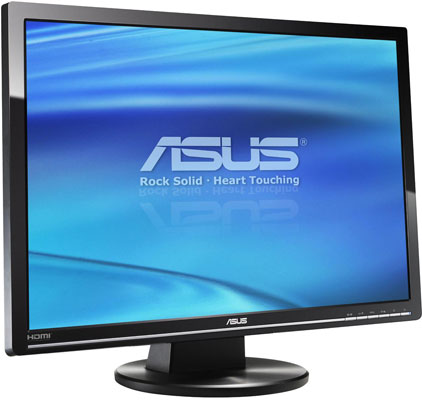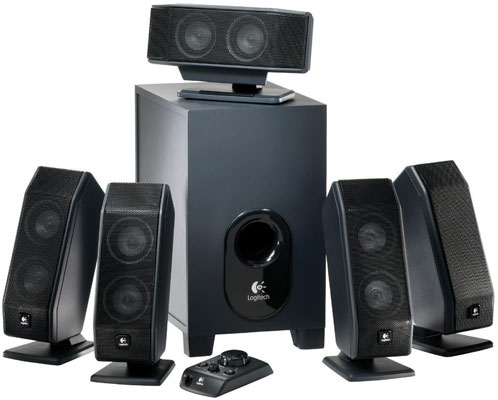System Buyer’s Guide: $1700 Performance Midrange
by Mike Jones and Jarred Walton on May 12, 2010 4:52 AM ESTMonitor, Speakers, and Input Devices
If you don’t already own these components, here are some additional peripherals to fill out your shopping cart.
| System Accessories | ||||
| Hardware | Component | Price |
Estimated Shipping |
Rebate |
| Display | ASUS VW266H Black 25.5" 2ms (GTG) HDMI Widescreen LCD Monitor (1920x1200) | $310 | $12 | ($30) |
| Speakers | Logitech X-540 70 watts 5.1 Speakers | $89 | ||
| Input | Microsoft Comfort Curve Desktop 2000 Black USB Keyboard and Optical Mouse – OEM | $28 | $8 | |
| Operating System | Microsoft Windows 7 Home Premium OEM 1-Pack (for System Builders) | $100 | ||
For an LCD, you could do a lot worse than the 25.5 inches of 2ms, 1920x1200 real estate offered by the ASUS VW266H. ASUS continues to build quality LCDs and includes HDMI connectivity (if not cables) at surprisingly low price points. Currently priced at $310 ($280 after mail-in rebate), the VW266H offers crisp images, good colors, D-Sub, DVI, HDMI, and component connectors, as well as an SPDIF out. It doesn’t include an HDMI cable, but for a monitor of this size at this price it’s difficult to complain.

Stepping down to 23” 1080p can save $100 or more and allows you to choose between several 23” 1080p displays. The ASUS VH236H is an attractive option, offering performance and connectivity on par with its larger sibling, and is currently available for $200 ($180 after $20 mail in rebate). Acer’s popular and well-regarded 23” P235Hbmid is another compelling option at the $200 price level, and it even includes an HDMI cable. If you’re really looking to shave off a couple of extra pennies, you can purchase the 21.5” 1080p ASUS VH222H for $170 ($160 after $10 mail in rebate), which is similar to the 23” version in every respect except for size.
All of the above offer great blends of value and performance, along with excellent connectivity. While you can certainly find less expensive 23” or 21.5” monitors, most will not include an HDMI connector, and you will want to be sure to research any bargain monitor whose price seems too good to be true. As the adage suggests, more often than not, “you get what you pay for.” Note that all of the displays are also TN panels, which work well enough for most users but certainly won't surpass quality IPS displays. If you want an IPS display, expect to pay around twice as much as the TN panels for a similar size display.

As the “speakers” included with most monitors are jokes no one seems to find particularly funny, it is difficult to recommend using them for anything other than a bargain basement machine. They certainly have no place in the sound system of a performance midrange machine. For a 5.1 system, the 70 Watt Logitech X-540 will definitely get the job done nicely, especially when you consider its $89 price tag. It won’t be mistaken for an audiophile grade rig, but it’s a great fit for gaming surround sound without breaking the bank. Logitech also offers a more robust 505 Watt system, but at $377 the THX-certified Z-5500 is difficult to recommend for a midrange system. As an aside, there is a disappointing lack of quality surround sound systems available in the $100-$350 price range, which makes it difficult to recommend other options.
There are many options in 2.1 systems, however, and it shouldn’t be hard to find something that will sound nice and fit your budget. The 200 Watt, THX Certified Logitech Z-2300 is a popular choice among system builders, and offers a loud (120 watts RMS) subwoofer. At $150, it offers a good mix of performance and price. The Creative Inspire T3130 2.1 speakers are a considerably less expensive option, though at $50 they are of course somewhat less robust (20 Watts total). Just the same, they will be a vast improvement over any speakers that come in the same box as your monitor.
For input devices, the Microsoft Comfort Curve Desktop 2000 fits the bill as the old standby. The keyboard is fine and, if you have no intention of gaming, the mouse will suffice for basic computing tasks. However, someone building this machine—and spending over $300 on a graphics card—probably intends to game with it. If that same someone doesn’t already have a gaming mouse they love, the Logitech MX518 is a popular option and at $43 won’t kill the bankroll. It features eight programmable buttons, custom sensitivity settings, and delivers 1800 dpi resolution. A slightly more upscale option is the Logitech G500, which costs $57, features 10 buttons, a dual-mode scroll wheel, resolution up to 5700 dpi, and the ability to adjust its weight to your preference.










102 Comments
View All Comments
GullLars - Wednesday, May 12, 2010 - link
Logical fail; strawman argument.
The motherboard on either setup has 6 SATA ports, not 1. You are not limited to using 1 storage device.
Also, most users that watch BluRay films has either a PS3/xbox360 or a BluRay player. Choosing a BD player over an SSD for this build makes me want to go /wallbash
I would also like to correct you on another point. Windows 7 64Bit proffesional edition with all updates and security essentials + MS office + Open office + Firefox + Burning program and most other _core apps_ will take up roughly 16GB once pagefile and hibernation is deactivated (or pagefile reduced to a few hundred MBs). Adding the full CS4 suite, a music editing program, 3DS max, and a couple of other apps will still leave you around the 30GB mark.
It's not much trouble at all to set up W7 to have OS + Apps on a SSD, and have a 1TB(+) HDD for all media, games, and others. Configuring "libraries" takes 1 minute and is easy to do. I've made libraries on a partition _NOT C:_ for: Pictures, Music, Videos, Documents, and Downloads on all computers i've set up. Running Ccleaner once a week keeps you from building up temp files on C, and restricting system restore to using 1-2GB will keep it from inflating over time.
whatthehey - Thursday, May 13, 2010 - link
Nice try, but people aren't that stupid. Straw man argument:http://en.wikipedia.org/wiki/Straw_man
Accusing Jarred of using straw man: EPIC fail! Accusing your opponent of using a straw man in order to pretend he didn't say anything useful on the other hand happens to be a form of the straw man argument, so congratulations!
Now, where did he misrepresent someone's position in order to knock it down and thereby make his position stronger? All I can see is that he said Anand loves SSDs. He gave examples of other things where he may not agree like Macs. He points out that SSDs cost a lot of money. Where is the attempt to refute something without actually refuting it?
Elsewhere, Jarred admits that the Blu-ray is unnecessary, and the article text now reflects this. So get off the damn high horse and quit bitching and moaning about what amounts to a difference of opinion. Sheesh!
GullLars - Thursday, May 13, 2010 - link
The strawman part was representing SSD as a replacement for a HDD and arguing that it's too low capacity and too expensive.The case you want to use an SSD in the majority of cases in is an addition to a HDD. Then capacity demands are way low, and the price pr GB can easily be justified because of the system acceleration effect.
AssBall - Thursday, May 13, 2010 - link
What part of his explanation of wanting to keep all of his files in the same place did you not understand? Go make your own damned buyer's guide if you are having so much trouble accepting or understanding this one.GullLars - Thursday, May 13, 2010 - link
I understand he wants that, but it's not an argument against an SSD as a system drive. You could simply move all documents to the harddisk, and have them in one place there.I'm not looking for a flamewar here, but i don't like it when people misrepresent the uses of SSDs.
The number one reason to use an SSD is system and application acceleration, not storage. The reasonable capacity range for that starts around 32GB, at wich point you will fit the entire OS and quite a bit more. Not being able to put everything you might want on it, and therefore ruling it out, denies you the benefits the stuff that would fit would get.
Jediron - Tuesday, May 18, 2010 - link
While he explains his preference, it's still his own personal preference. A good reviewer should look beyond that. SSD's are becoming more and more populair and i understand why. More populair then Blueray drives, but, aldo he admits it is not a dealmaker; the Blueray player is chosen in the configuration. WHY?The WD Black 1TB i can understand, WD Black series come with a 5 year warranty. That's a good argument to pay a little extra.
futrtrubl - Wednesday, May 12, 2010 - link
You can pretty easily have it set up so the \users folder is located on another drive with it behaving exactly is it currently does. It`s how my computer is set up in fact.spigzone - Sunday, May 23, 2010 - link
" For $100 I can get a 1TB hard drive"make that a 1.5TB hard drive for $99.
or 2TB for $119.
jleach1 - Wednesday, May 12, 2010 - link
You guys are dumb. There is more than one way a system can be mid-range. This PC is midrange performance-wise...not money-wise. Don't be stupid. Use your brain. And if you make less than a thousand dollars a year....move.Phate-13 - Wednesday, May 12, 2010 - link
Excuse me?!This system has quite top-notch performance.
I'll quote myself: "You can play (almost) any game at its maximum with that config, how can you call that midrange?" A system of 900 is low-range to you then? That makes no sense at all.